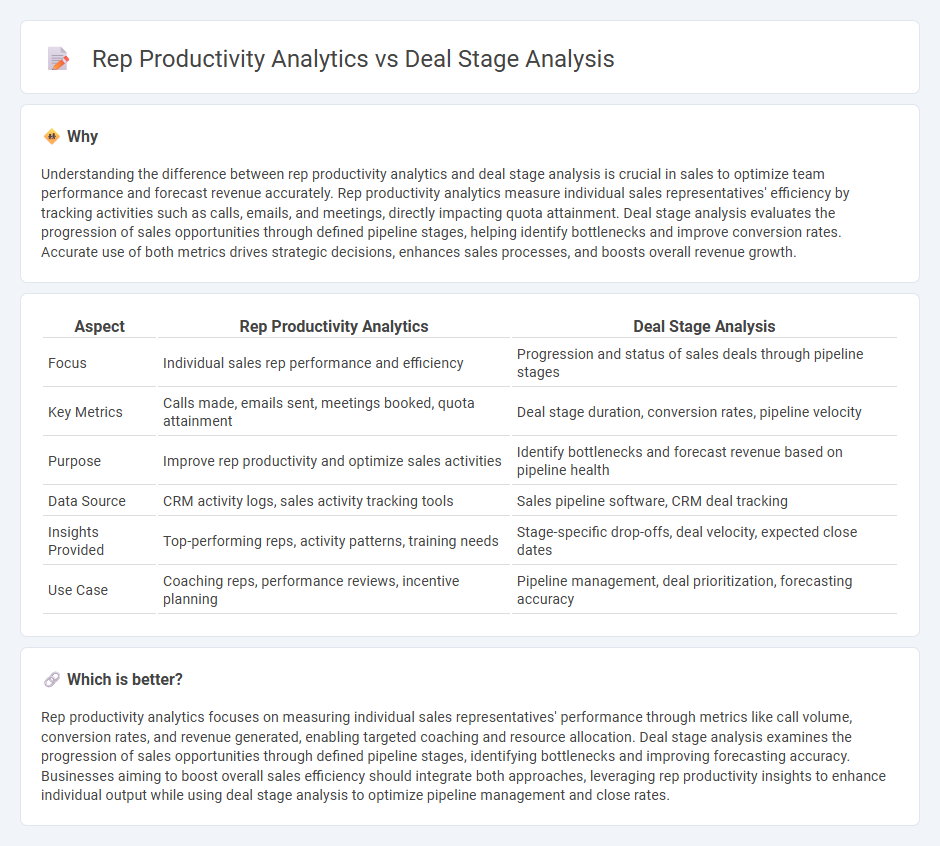
Sales rep productivity analytics evaluates individual and team performance by tracking key metrics such as call volume, conversion rates, and revenue generated, providing actionable insights for optimizing sales efforts. Deal stage analysis focuses on monitoring the progression of opportunities within the sales funnel, identifying bottlenecks and predicting deal closures based on stage duration and win probabilities. Explore these approaches to enhance your sales strategy and drive higher revenue growth.
Why it is important
Understanding the difference between rep productivity analytics and deal stage analysis is crucial in sales to optimize team performance and forecast revenue accurately. Rep productivity analytics measure individual sales representatives' efficiency by tracking activities such as calls, emails, and meetings, directly impacting quota attainment. Deal stage analysis evaluates the progression of sales opportunities through defined pipeline stages, helping identify bottlenecks and improve conversion rates. Accurate use of both metrics drives strategic decisions, enhances sales processes, and boosts overall revenue growth.
Comparison Table
| Aspect | Rep Productivity Analytics | Deal Stage Analysis |
|---|---|---|
| Focus | Individual sales rep performance and efficiency | Progression and status of sales deals through pipeline stages |
| Key Metrics | Calls made, emails sent, meetings booked, quota attainment | Deal stage duration, conversion rates, pipeline velocity |
| Purpose | Improve rep productivity and optimize sales activities | Identify bottlenecks and forecast revenue based on pipeline health |
| Data Source | CRM activity logs, sales activity tracking tools | Sales pipeline software, CRM deal tracking |
| Insights Provided | Top-performing reps, activity patterns, training needs | Stage-specific drop-offs, deal velocity, expected close dates |
| Use Case | Coaching reps, performance reviews, incentive planning | Pipeline management, deal prioritization, forecasting accuracy |
Which is better?
Rep productivity analytics focuses on measuring individual sales representatives' performance through metrics like call volume, conversion rates, and revenue generated, enabling targeted coaching and resource allocation. Deal stage analysis examines the progression of sales opportunities through defined pipeline stages, identifying bottlenecks and improving forecasting accuracy. Businesses aiming to boost overall sales efficiency should integrate both approaches, leveraging rep productivity insights to enhance individual output while using deal stage analysis to optimize pipeline management and close rates.
Connection
Rep productivity analytics enhances sales performance by tracking individual efficiency metrics such as call volumes, conversion rates, and average deal sizes, which directly impact revenue generation. Deal stage analysis complements this by providing detailed insights into the progression of opportunities within the sales pipeline, identifying bottlenecks and forecasting closure probabilities. Combining these two analytics approaches enables sales managers to optimize resource allocation, tailor coaching strategies, and accelerate deal velocity for improved sales outcomes.
Key Terms
Deal Stage Analysis:
Deal stage analysis provides detailed insights into the progression of sales opportunities through various pipeline phases, highlighting conversion rates, bottlenecks, and average time spent at each stage. This analysis enables sales leaders to optimize processes, forecast revenue more accurately, and enhance overall pipeline efficiency. Discover how deal stage analysis can transform your sales strategy and revenue outcomes.
Pipeline Progression
Deal stage analysis provides insights into the movement of opportunities through the sales funnel by tracking conversion rates and identifying bottlenecks at each phase, which is crucial for optimizing pipeline progression. Rep productivity analytics measures individual sales representatives' effectiveness by evaluating metrics such as deal velocity, touchpoints, and win rates, helping to pinpoint areas for performance improvement. Explore our detailed comparison to understand how integrating both approaches enhances pipeline management and accelerates revenue growth.
Conversion Rates
Deal stage analysis concentrates on tracking the percentage of opportunities that advance through sales pipeline phases, providing insight into bottlenecks and efficiency at each stage. Rep productivity analytics evaluates individual sales representatives' performance by measuring conversion rates, deal velocity, and closed deals to identify strengths and areas for improvement. Explore how integrating these metrics can optimize sales strategies and boost overall team performance.
Source and External Links
What are Deal Stages? - DealHub - Deal stages are defined steps in the sales process guiding a potential customer from first contact through to final decision, helping teams track progress, focus efforts, and close deals by moving through prospecting, qualification, proposal, negotiation, and decision-making phases.
Everything You Need to Know When Assessing Deal Stages Skills - Alooba - Deal stages represent key sales milestones from identifying leads, qualifying prospects, understanding needs, to presenting proposals and negotiating terms, allowing salespeople to manage time and resources based on the deal's progression.
CRM Deal Stages: HubSpot Functions Explained - Project36 - In HubSpot CRM, deal stages map the steps from initial contact to sale closure, with stages assigned probabilities to aid forecasting, identify bottlenecks, and optimize sales strategies through pipeline visualization and customizable stages.
 dowidth.com
dowidth.com